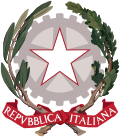| Umbria region | |
| Capital | Perugia |
|---|---|
| Residents | 882.015 (2019) |
| surface | 8,456 km² |
| no tourist info on Wikidata: | |
| location | |
 | |
Umbria (Italian Umbria) is a region in Italy. It lies inland and borders the regions Tuscany, Lazio, Brands and Abruzzo. The capital is Perugia
Regions
- Provinces
- Perugia (PG)
- Terni (TR)
- Landscapes
places


- 1 Perugia
 - Regional capital
- Regional capital - 2 Assisi
 - Birthplace of Francis of Assisi
- Birthplace of Francis of Assisi - 3 Foligno

- 4 Orvieto
 - very old city (Etruscan period) on a tuff rock with an underground grotto, cellar and passageway system
- very old city (Etruscan period) on a tuff rock with an underground grotto, cellar and passageway system - 5 Spoleto

- 6 Terni
- 7 Todi

- 8 Gubbio

- 9 Montefalco

- 10 Città di Castello

- 11 Montone
 - one of the "100 Borghi più belli d'Italia", the most beautiful places in Italy. The medieval urban structure is still completely preserved, and in contrast to many other places with similarly well-preserved substance, Montone also has a lively infrastructure.
- one of the "100 Borghi più belli d'Italia", the most beautiful places in Italy. The medieval urban structure is still completely preserved, and in contrast to many other places with similarly well-preserved substance, Montone also has a lively infrastructure. - 12 Trevi (Umbria)

- 13 Spello

Other goals

- Corciano
- Lake Trasimeno (Lake Trasimeno)
- Piediluco lake
- Gargano National Park with old pine forests and the Foresta Umbra (Beech forests)
background
The region with an area of 8,456 km² and 820,316 inhabitants is the only one in Italy that does not border the sea or other countries. The landscape of Umbria is mainly characterized by the Umbrian Apennines in the east with the impressive Monte Vettore (2,478 m) and the Tiber basin to the west.
Umbria is known as the “green lung” of Italy because of its numerous wooded hills and mountains. "Umbra" (Latin) means shade and may refer to the many shady trees or to the fact that Umbria with its picturesque villages and many sights is often in the shadow of Tuscany.
language
Italian
getting there
By plane
The airport "San Francesco d'Assisi" Perugia airport(IATA: PEG) has so far been of secondary importance, but is growing. Offers in summer Ryanair a direct connection with twice a week Frankfurt am Main (FRA).
The next major international airports are Rome Fiumicino Airport![]() (IATA: FCO) or -Ciampino (CIA) for the south of Umbria (115 or 135 km from Terni) as well Ancona airport(IATA: AOI) 115 km from Perugia) or Florence Airport(IATA: FLR) ; 165 km from Perugia) for the north of the region. However, the connection from these to Umbria by public transport is cumbersome and lengthy. It is therefore advisable to take a rental car for the onward journey (which is an advantage in rural Umbria anyway).
(IATA: FCO) or -Ciampino (CIA) for the south of Umbria (115 or 135 km from Terni) as well Ancona airport(IATA: AOI) 115 km from Perugia) or Florence Airport(IATA: FLR) ; 165 km from Perugia) for the north of the region. However, the connection from these to Umbria by public transport is cumbersome and lengthy. It is therefore advisable to take a rental car for the onward journey (which is an advantage in rural Umbria anyway).
By train
You can take the ÖBB NightJet (night train) from Munich / Salzburg or Vienna / Klagenfurt in the direction of Rome Orvieto drive in the south of Umbria. If you want to go to the north or the center of Umbria, you can go to Arezzo or get off at Chiusi / Chianciano Terme, where there is a connection with regional trains in the direction of Perugia or Lake Trasimeno.
The Italian high-speed trains (Frecce or Italo) usually speed through Umbria without stopping on the way between Rome and Florence.
The "slow" line Rome–Florence runs through the southwest of Umbria, with a stop in Orvieto. It is operated by Intercity (Milan–Florence–Naples or Rome–Bologna–Trieste) as well as regional express (Rome – Florence). The latter also stops in Terontola / Cortona (you can change trains in the direction of Perugia) and Castiglione on Lake Trasimeno. The regional express line Rome -Ancona with hold and others in Terni, Spoleto, Foglino and Fossato di Vico /Gubbio.
The regional capital, of all places Perugia is very badly connected to the rail traffic. Regional trains on the Florence – Arezzo – Perugia – Foglino line or from / to Terontola-Cortona in eastern Tuscany stop here every two hours.
mobility
Tourist Attractions
- basilica and Memorials of St. Francis in Assisi
- Old town Orvieto: Erected on a tufa rock. The history of the city goes back to the Etruscan period. It was probably one of the 12 cities of the Etruscan League of Cities. A labyrinth of cellars, corridors, cisterns and grottos was carved into the rock under the city. Particularly noteworthy is the 58-meter-deep Pozzo di San Patrizio fountain from the 16th century with spiral stairs for donkeys that carry water to ensure the water supply even during times of siege. Other attractions include the funicular and the magnificent Gothic cathedral with valuable Renaissance frescoes by Luca Signorelli
- Basilica of San Salvatore in Spoleto - Early Christian church built on the basis of a Roman temple from the 4th / 5th centuries. century
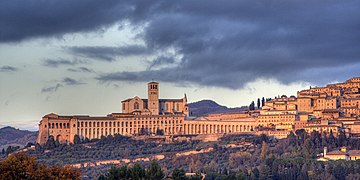
Assisi
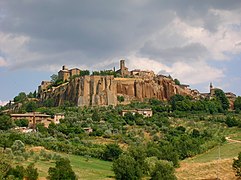
Orvieto

Orvieto Cathedral
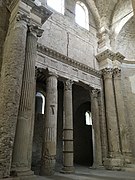
San Salvatore Basilica, Spoleto
- Tempietto del Clitunno in Campello sul Clitunno - Early medieval sanctuary from the 6th to 8th centuries, material from older, pagan temples was used for its construction. Inside, frescoes by Lo Spagna from the 16th century
- Teatro della Concordia: smallest Teatro all'italiana the world stands in Monte Castello di Vibio
- Cascata delle Marmore and Valnerina
- Dunarobba fossil forest

Tempietto del Clitunno
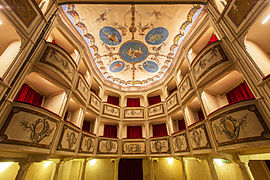
Teatro della Concordia
Cascata delle Marmore

Dunarobba fossil forest
activities
kitchen
nightlife
security
climate
| Perugia | Jan | Feb | March | Apr | May | Jun | Jul | Aug | Sep | Oct | Nov | Dec | ||
|---|---|---|---|---|---|---|---|---|---|---|---|---|---|---|
| Mean highest air temperature in ° C | 4.1 | 4.6 | 11.5 | 16.8 | 20.8 | 24.5 | 28.5 | 26.9 | 23.8 | 17.6 | 15.5 | 7.5 | O | 16.8 |
| Mean lowest air temperature in ° C | 0.4 | 0.7 | 4 | 8 | 11.5 | 14.8 | 18.9 | 17.2 | 15.2 | 10.7 | 9.3 | 3.5 | O | 9.5 |
literature
- A good educated guide is: Umbria Guide Illustrata con pianta della Regione in Italian. It could be that this travel guide is still available in German.
- A very detailed travel guide, but in Italian: Guida d'Italia Umbria



.jpg/350px-06034_Foligno,_Province_of_Perugia,_Italy_-_panoramio_(13).jpg)


.jpg/321px-Castello_di_Miranda_(XI-XII_secolo,_sullo_sfondo_è_visibile_la_valle_di_Terni).jpg)




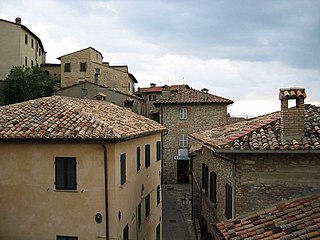



.jpg/350px-Rom_Fiumicino_24_(raboe).jpg)










